Citroen C8 2013 1.G User Guide
Manufacturer: CITROEN, Model Year: 2013, Model line: C8, Model: Citroen C8 2013 1.GPages: 234, PDF Size: 8.86 MB
Page 11 of 234
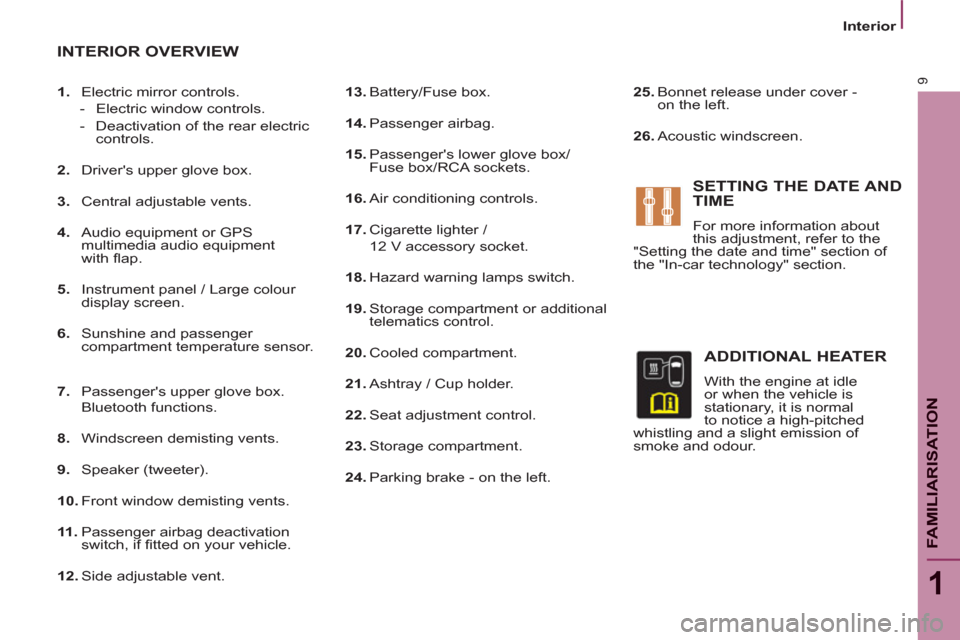
9
1
FAMILIARISATIO
N
Interior
13.
Battery/Fuse box.
14.
Passenger airbag.
15.
Passenger's lower glove box/
Fuse box/RCA sockets.
16.
Air conditioning controls.
17.
Cigarette lighter /
12 V accessory socket.
18.
Hazard warning lamps switch.
19.
Storage compartment or additional
telematics control.
20.
Cooled compartment.
21.
Ashtray / Cup holder.
22.
Seat adjustment control.
23.
Storage compartment.
24.
Parking brake - on the left.
1.
Electric mirror controls.
- Electric window controls.
- Deactivation of the rear electric
controls.
2.
Driver's upper glove box.
3.
Central adjustable vents.
4.
Audio equipment or GPS
multimedia audio equipment
with fl ap.
5.
Instrument panel / Large colour
display screen.
6.
Sunshine and passenger
compartment temperature sensor.
7.
Passenger's upper glove box.
25.
Bonnet release under cover -
on the left.
26.
Acoustic windscreen.
INTERIOR OVERVIEW
SETTING THE DATE AND
TIME
For more information about
this adjustment, refer to the
"Setting the date and time" section of
the "In-car technology" section.
ADDITIONAL HEATER
With the engine at idle
or when the vehicle is
stationary, it is normal
to notice a high-pitched
whistling and a slight emission of
smoke and odour.
Bluetooth functions.
8.
Windscreen demisting vents.
9.
Speaker (tweeter).
10.
Front window demisting vents.
11 .
Passenger airbag deactivation
switch, if fi tted on your vehicle.
12.
Side adjustable vent.
Page 12 of 234
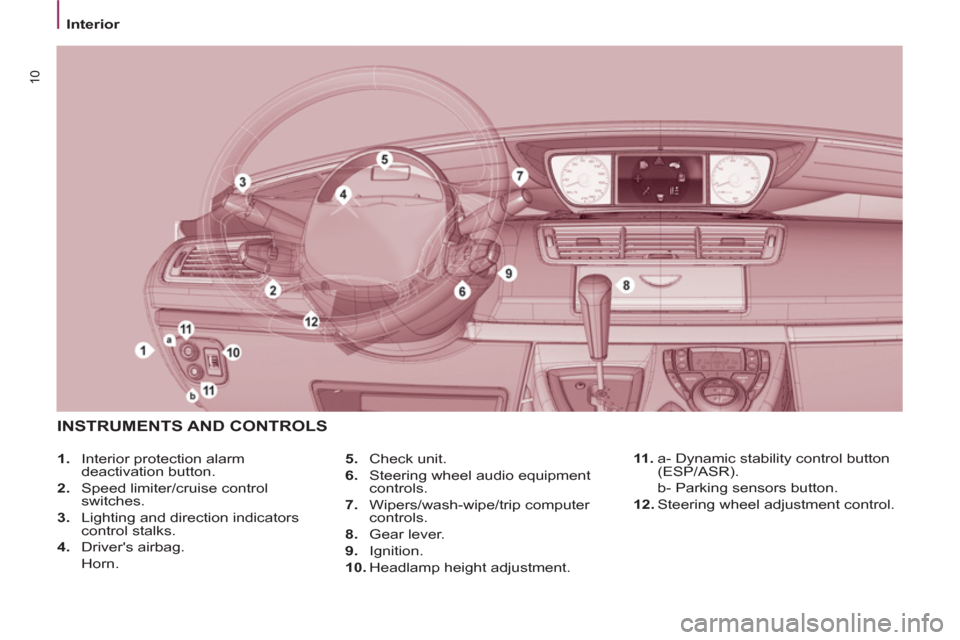
10
Interior
5.
Check unit.
6.
Steering wheel audio equipment
controls.
7.
Wipers/wash-wipe/trip computer
controls.
8.
Gear lever.
9.
Ignition.
10.
Headlamp height adjustment.
1.
Interior protection alarm
deactivation button.
2.
Speed limiter/cruise control
switches.
3.
Lighting and direction indicators
control stalks.
4.
Driver's airbag.
Horn.
11 .
a- Dynamic stability control button
(ESP/ASR).
b- Parking sensors button.
12.
Steering wheel adjustment control.
INSTRUMENTS AND CONTROLS
Page 13 of 234

9
9
9
11
1
FAMILIARISATIO
N
Interior
INSTRUMENTS AND CONTROLS
Truly ergonomic control for
access to the functions of
the NaviDrive.
confi rmation
selection
eMyWay
Audio system
Bluetooth functions
JACK/RCA socket
Page 14 of 234

4
12
Interior
86 Seat with manual
adjustment
Seat with electric
adjustment
If your vehicle
is fi tted with a
version with a
rotating front
seat, pull the
button placed at
the end of the
parking brake
forwards.
The parking brake
lever lowers.
You can now rotate the seat. To return
to normal operation, pull the lever up
until it clicks.
1.
Forwards-backwards
adjustment.
2.
Angle.
3.
Height.
4.
Lumbar.
5.
Head restraint
height and angle.
Rotating the seat
SITTING COMFORTABLY
Driver's seat
Page 15 of 234

3
13
1
FAMILIARISATIO
N
Interior
Linked outer seats Central rear seat
Rear bench seat
Other types of seat
64
Page 16 of 234
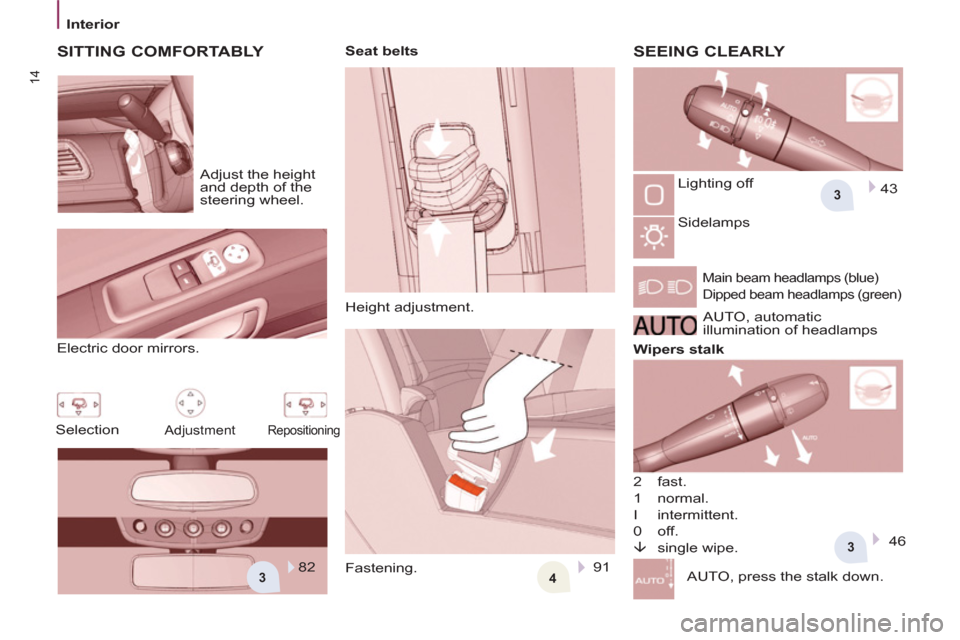
43
3
3
14
Interior
91
Repositioning
SITTING COMFORTABLY
SEEING CLEARLY
Adjust the height
and depth of the
steering wheel.
Electric door mirrors.
Selection
Seat belts
Height adjustment.
Fastening. Lighting off
Sidelamps
Main beam headlamps (blue)
Dipped beam headlamps (green)
Wipers stalk
2 fast.
1 normal.
I intermittent.
0 off.
�È
single wipe.
AUTO, press the stalk down. AUTO, automatic
illumination of headlamps
Adjustment
82
43
46
Page 17 of 234
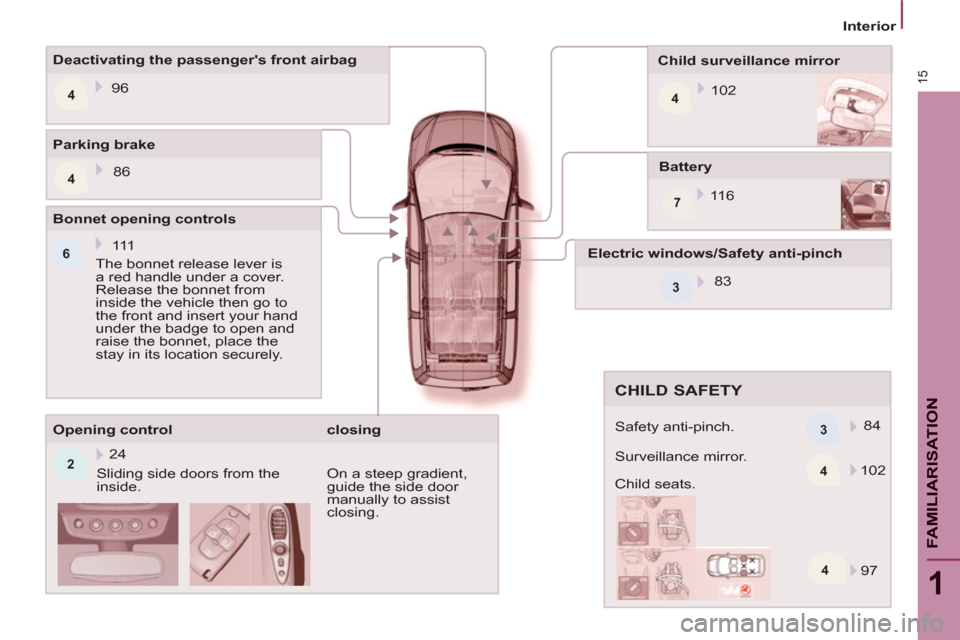
4
244
7
6
4 3 3
415
1
FAMILIARISATIO
N
Interior
Battery
11 6
Child surveillance mirror
102
Deactivating the passenger's front airbag
96
Opening control
Sliding side doors from the
inside. 24
Parking brake
86
Bonnet opening controls
The bonnet release lever is
a red handle under a cover.
Release the bonnet from
inside the vehicle then go to
the front and insert your hand
under the badge to open and
raise the bonnet, place the
stay in its location securely. 111
Safety anti-pinch.
97 102 84 83
Electric windows/Safety anti-pinch
CHILD SAFETY
Surveillance mirror.
Child seats.
closing
On a steep gradient,
guide the side door
manually to assist
closing.
Page 18 of 234

3
3
16
Interior
VENTILATION
65 - 73
56
ADAPT CORRECTLY
Automatic with separate adjustment
Press, AUTO is displayed, this is the
usual mode.
Details of the modularity of the seats
are indicated in chapter 3.
Good practice when moving a seat.
Observe the order of the steps referred
to in the document, place the head
restraint in the lowest position, fold
the seat back onto the seat cushion,
ensure that the refi tting position is
compatible with the type of seat, offer
up the front feet of the seat directly
above the slides or retaining hooks on
the fl oor before triggering the refi tting
of the rear feet.
Air conditioning
Page 19 of 234
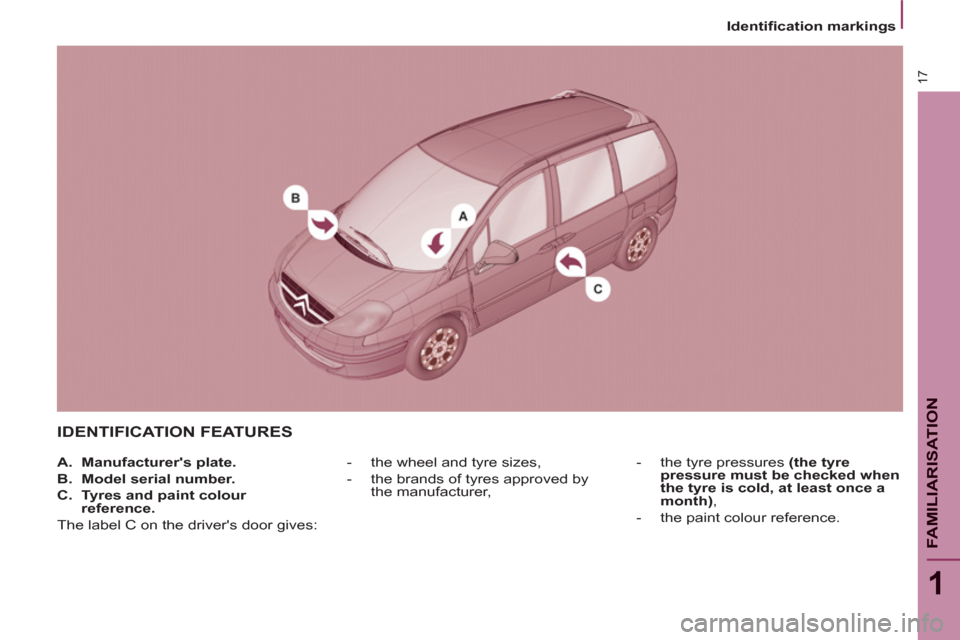
17
1
FAMILIARISATIO
N
Identifi cation markings
IDENTIFICATION FEATURES
-
the wheel and tyre sizes,
-
the brands of tyres approved by
the manufacturer,
-
the tyre pressures (the tyre
pressure must be checked when
the tyre is cold, at least once a
month)
,
-
the paint colour reference.
A.
Manufacturer's plate.
B.
Model serial number.
C.
Tyres and paint colour
reference.
The label C on the driver's door gives:
Page 20 of 234
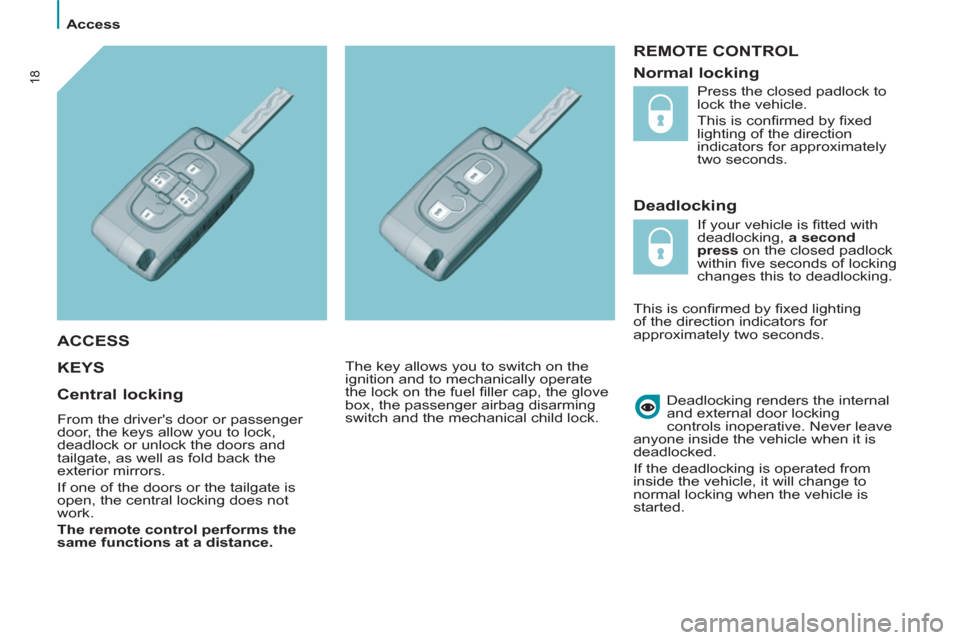
Access
18
REMOTE CONTROL
Deadlocking
KEY
S
Deadlocking renders the internal
and external door locking
controls inoperative. Never leave
anyone inside the vehicle when it is
deadlocked.
If the deadlocking is operated from
inside the vehicle, it will change to
normal locking when the vehicle is
started.
ACCESS
Press the closed padlock to
lock the vehicle.
This is confi rmed by fi xed
lighting of the direction
indicators for approximately
two seconds.
Central locking
From the driver's door or passenger
door, the keys allow you to lock,
deadlock or unlock the doors and
tailgate, as well as fold back the
exterior mirrors.
If one of the doors or the tailgate is
open, the central locking does not
work.
The remote control performs the
same functions at a distance.
The key allows you to switch on the
ignition and to mechanically operate
the lock on the fuel fi ller cap, the glove
box, the passenger airbag disarming
switch and the mechanical child lock.
Normal locking
If your vehicle is fi tted with
deadlocking, a second
press
on the closed padlock
within fi ve seconds of locking
changes this to deadlocking.
This is confi rmed by fi xed lighting
of the direction indicators for
approximately two seconds.